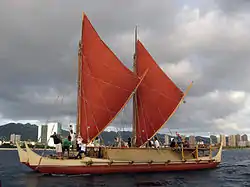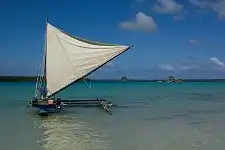Pelang
Pelang or pilang is a traditional boat from Indonesia and Malaysia. It may refer to several different type of boats in the Nusantara, but commonly they refer to outrigger canoe. The function differs from where they were used, from transporting people, fishing, to trading. Pilang has been known from at least the 14th century.[1]

Etymology
The name "pelang" can be traced from Old Javanese word pelang which means freight boat or a type of ancient merchant boat.[2] The Great Indonesian Dictionary (KBBI) explain it as "trading boat".[3]:1039 According to M. Rafiek, pelang is a rather large boat used to sail through the Java sea.[4]

In northern Sulawesi, It was originally a term for a mahera-based boat (mahera means dugout - the base keel made from a whole piece of hollowed wood), but with the influx of Filipino technology (see vinta), then a boat made of waterproof plywood can also be referred to as a pelang.[5]
Description
In western part of Nusantara, it refers to a large, flat bottomed canoe-like boat with one mast, stepping a lug sail made of cloth. Usually built of giam wood. H. Warington Smyth noted the dimensions of a pilang: About 42 ft (12.8 m) long, 5 ft (1.5 m) wide, 2 ft 3 in (69 cm) draught, with 1 ft (30 cm) of freeboard. The capacity was 1 koyan (2.419 metric tons). The mast itself is about 40 ft (12.2 m) tall.[6]
In the eastern part of Nusantara, the name refers to small, canoe-like outrigger boat. In Northern coast of Sulawesi, pelang refers to outrigger fishing boat. North Sulawesian pelang is about 6-8 m in length, 1 m in width and crewed by 4-6 men. This pelang has an operational range of 5-7 miles (8-11.3 km).[7] The Mahera (dugout base) does not have enough height to be used as a boat. Thus, the mahera is in the form of the flat keel of wood with a slight curvature. To improve the seaworthiness, additional side planks were added. The side planks are made of marine plywood with some frame construction and side beams as reinforcement. Modern pelang of Northern Sulawesi were equipped with outboard motors. The motor gradually replaced the sail in the 1970s.[5]

There are also pelang that are equipped with lamps and electric generator for light fishing. Lights were used to attract fish for improving the quantity of the catch. The raw material is marine plywood with a length of about 7 m.[5]
See also
References
- Hikayat Banjar, 1.2: Then Ampu Djatmaka sailed with the same boat following it. Kapal and pilang are not as speedy as Si Prabayaksa; the size and the length and the ornamentation [of them] does not surpass Si Prabayaksa.
- Petrus Josephus Zoetmulder, 1982, Old Javanese – English Dictionary, The Hague: Martinus Nijhoff. 2 v. (xxxi, 2368 p.) In collaboration with S.O. Robson.
- Departemen Pendidikan Nasional (2008). Kamus Besar Bahasa Indonesia Pusat Bahasa Edisi Keempat. Jakarta: PT Gramedia Pustaka Utama.
- Rafiek, M. (December 2011). "Ships and Boats in the Story of King Banjar: Semantic Studies". Borneo Research Journal. 5: 187–200.
- Salam, Aziz (2018). "Technological Adaptation in Traditional Fisheries: Way to Survive". IOP Conf. Series: Earth and Environmental Science. 139.
- Smyth, H. Warington (16 May 1902). "Boats and Boat Building in the Malay Peninsula". The Journal of the Society of Arts. 50: 577 – via JSTOR.
- Kearifan Tradisional Masyarakat Nelayan Kampung Batunderang Yang Berkaitan dengan Pemeliharaan Lingkungan Alam di Kabupaten Kepulauan Sangihe - Sulawesi Utara (in Indonesian). Direktorat Jenderal Kebudayaan. 2007-01-01.



.jpg.webp)